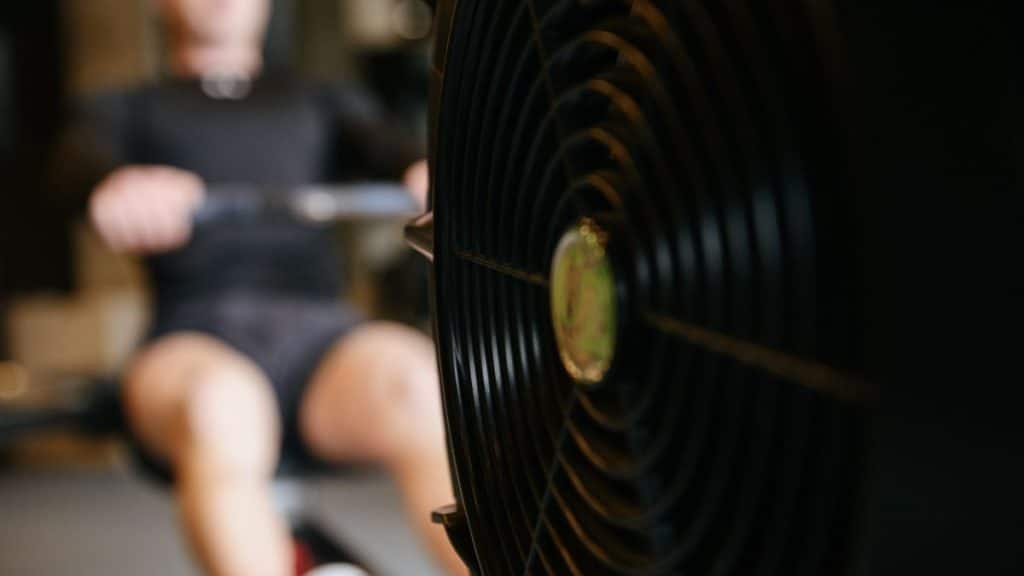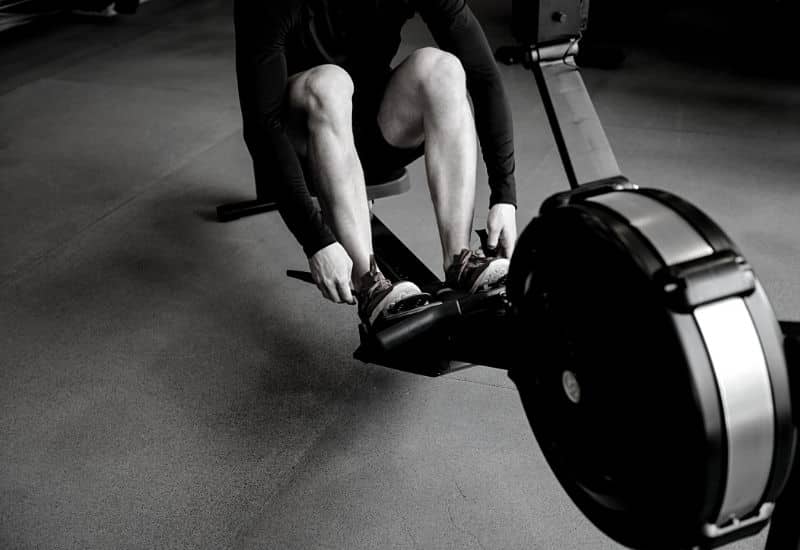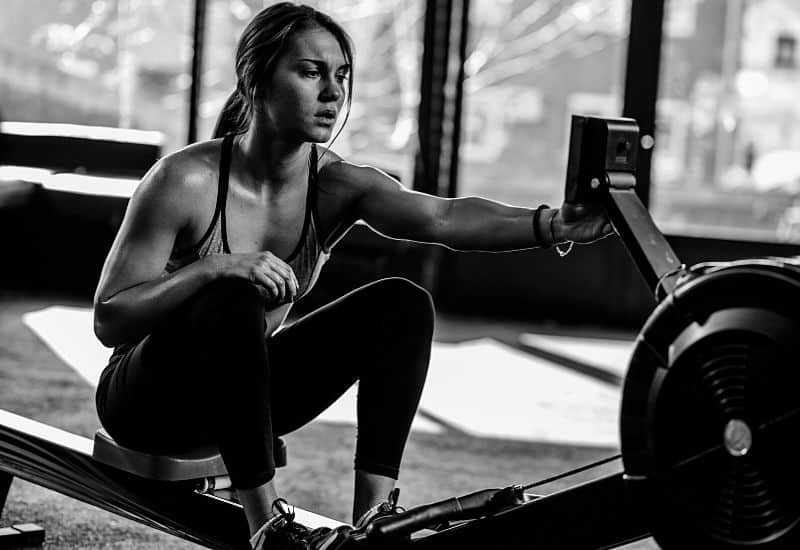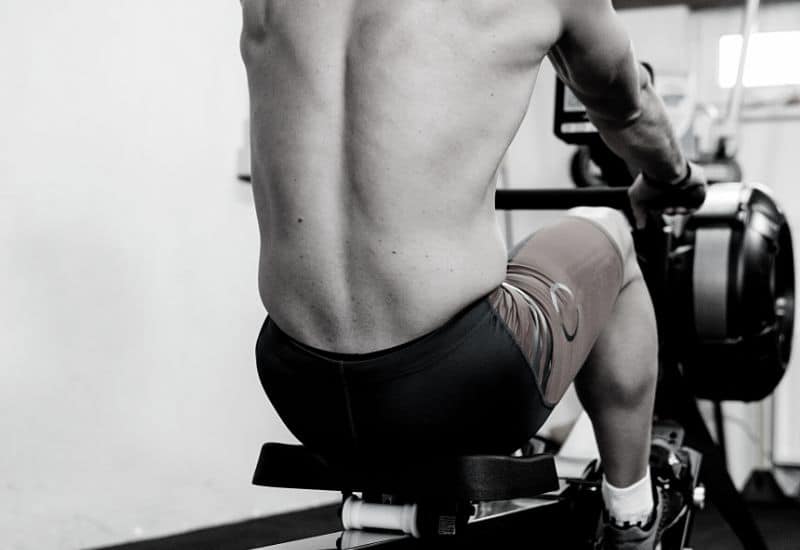The rowing machine is a killer cardio machine that can also help you build muscle… if done properly. Learn how to use the row machine for building muscle and try three of our favorite muscle-building workouts.

Rowing is one of the best forms of cardio, or cardiovascular exercise.
What that means is that it will increase your lungs’ ability to absorb oxygen, your heart’s ability to pump blood throughout your body, and your blood vessels’ ability to dilate to allow for increased blood flow.
But, like all good cardio, rowing can build muscles, too.
It’s not just about your cardiovascular conditioning; done right, it can boost muscular endurance and increase your stamina.
That’s what we’re going to explore in this post.
Below, we’ll look at which muscles are targeted by the rowing machine, how each “phase” of the rowing process works different muscles, and how you can build more muscle on the rowing machine.
By the end of this page, you’ll know how best to use the rowing machine to increase your muscular endurance (and even muscle mass) like a boss!
How the Rowing Machine Builds Mega Muscle
Before we dive into all the muscles worked on the rowing machine, it’s important to understand exactly how the rowing movement works your body.
That way, you’ll have a much clearer idea of just how your muscles engage so you know how to focus on them during your training.
Rowing is broken down into four “stages” or “phases”:
Phase 1: The Catch.
During this phase, you’re as far forward as possible, with your shins vertical to the floor, your arms fully extended in front of you, and a slight lean (to 11 o’clock position) so your core muscles are ready to engage when you start pulling.
This is the “set up” just before you start doing the work.
Phase 2: The Drive.
This is the phase where you push backward with your legs, engaging your core muscles to keep your upper body stable and begin to lean backward, too.
You start off by driving backward with your legs, lean your upper body back, and finish off by pulling with your arms. When performed correctly, the smooth movement delivers an efficient rowing stroke.
Phase 3: The Finish.
The “finish” is where you end up after the “drive”, with your upper body leaning slightly backward (at 1 o’clock position), your legs fully extended, and your hands pulling the rowing machine handle against your torso. This is how you finish every stroke.
Phase 4: The Return.
Also known as “the recovery” phase, this is when you slide your seat forward to return to the “catch” position. With the drive, you moved your legs first, then your hips and torso, and finally your arms.
With the return, you do it all in reverse—hands first, then hips and torso, and finally your legs. When you finish this movement, you will end up ready to start all over again.

It takes a bit of practice to get right, but the truth is that the rowing stroke is actually fairly easy to master once you break it down into these four phases.
You can easily remember to engage your muscles in the correct sequence (legs > hips/torso > arms during the drive, and arms > hips/torso > legs during the return) to make sure that rowing stroke is smooth and easy.
We can talk all about how one of the great benefits of rowing machines is increased mobility, thanks to this full-body movement.
One study1 found that just six weeks of training on a rowing machine generated significant decreases in fat mass and total fat body. The participants also showed that back and trunk flexion strength improved.
Because it works all those joints, you’ll find you have an easier time moving through a wide range of motion across multiple activities.
However, this article is focused on the “muscle” aspects (we’ll discuss joints in another post), so for the sake of brevity, let’s stick with that.
During each phase of the rowing movement, the same muscles do all the work:
Upper Body: Upper back, shoulders, biceps, forearms
Core: Abs and lower back
Lower Body: Hamstrings, glutes, hips, quads, and calves
Your legs do the majority of the work during the drive, as they are the first muscle to engage to push your body backward in the beginning of the rowing stroke.
However, your hips and core work next to lean your upper body backward, and your upper body finishes off as you row the handle to your torso.
All in all, it’s a full-body movement that engages nearly all of your muscles (just missing the “push” muscles in your chest and triceps).
This makes it one of the best cardio machines for building muscular endurance, as well as cardiovascular endurance!
How to Build More Muscle on the Rowing Machine
As with all forms of cardio, long-term sustained effort will build endurance rather than strength.
What’s the difference?
According to the experts2:
“Muscular strength is the amount of force you can put out or the amount of weight you can lift. Muscular endurance is how many times you can move that weight without getting exhausted (very tired).”
If you only rowed 5-25 times using very heavy weights (as you do with resistance training), it would build muscular strength.
But because you’re rowing literally hundreds (maybe even thousands) of times using very little weight, it builds endurance and increases your muscles’ ability to work without tiring.
If your goal is to increase your muscular endurance, here are a few things you can try:
✅ Increase the resistance.
Typically, when you just start off rowing, you probably set the resistance fairly low (50% or less) so your body has a chance to adapt to the exertion.
However, if you want to increase muscle-building, you can raise the resistance (to 75 or even 100%). This works your muscles harder with every rowing stroke, leading to faster fatigue but greater muscular endurance.
Trainer’s Note: As a bonus, raising the resistance will also increase the number of calories burned on the row machine during your workout.
✅ Row with one arm at a time.
You’ve seen above how important good form can be for keeping your body moving smoothly through the stroke. However, you can experiment with different things and see what works for you.
For example, rowing with one arm at a time will actually engage your core and “pull” muscles more effectively than two-handed rowing. Hold the handle in a one-handed grip right in the middle, and pull it toward your side rather than directly toward your torso, twisting your upper body as you pull.

This unilateral exercise will do wonders to strengthen your core and give you far more effective arm-muscle-building than standard rowing.
✅ Drive harder with your legs.
To really max out the lower body engagement, drive with your legs with all the force you can muster.
Your legs are already doing a lot of the work of propelling you backward and facilitating a smooth rowing stroke, but you can increase the intensity of the workout by pushing harder with your legs to really increase muscle contraction.
✅ Add in bodyweight movements.
Instead of spending your entire workout on the rowing machine, try rowing for a stretch (to target your cardio) then jumping off the rower to do a few muscle-focused bodyweight exercises.
For example:
- Row for 200 meters
- Do 15 push-ups or squats
This will deliver both the muscle-building and cardio-improving workout you want.
Workouts for Building Muscle on the Rowing Machine
Here are three simple yet highly effective workouts you can try for building muscle on the rowing machine:
⭐ Workout #1: Rowing Machine HIIT Workout
For this workout, your goal is to push your body to the max for a short interval, then give it a lower-intensity interval to let it rest and recover before going full-out again.
Doing this HIIT workout on the rowing machine will burn serious calories and build muscles. Plus, in just 20 minutes, you’ll be done!
The workout is simple:
Every Minute on the Minute (EMOM): Row 10 strokes as fast as you can. Spend the rest of the minute rowing at a slower pace.
Those 10 strokes will feel easy at first, but by the last 5-10 minutes, they will be exhausting!

⭐ Workout #2: Bodyweight Rowing Workout
This workout combines cardio-focused rowing with muscle-building-focused bodyweight exercises. Because you’re never really pausing to rest, you’ll keep your cardiovascular system working hard, but also engage your muscles to build both strength and endurance.
The key is to row at a “moderate” pace—not so fast that you’ll run out of breath, but not so slow that your heart rate settles.
Aim to keep your heart rate at roughly 65% during the rowing sessions. The bodyweight exercises (anaerobic training) will push your heart rate much higher.
Here’s the workout:
- Row for 250 meters
- As quickly as you can, jump off the rowing machine and do 15 push-ups
- Get back onto the rowing machine without pausing and row for 250 meters
- Do 10 squats
- Row for 250 meters
- Do 15 Pull-Ups
- Row for 250 meters
- Do 20 crunches
- Row for 250 meters
Repeat this circuit 2-4 times (depending on your time and endurance), or until you just can’t row or train any more.
⭐ Workout #3: Rowing Ladder Workout
This ladder workout focuses a lot more on your cardiovascular endurance thanks to its HIIT nature, but you can go through the entire session with the intensity set to 100% in order to also engage your muscles more effectively.
To perform the workout:
- Start out rowing at a moderate pace (usually 18 to 20 strokes per minute)
- Every minute on the minute, increase your pace by 1 SPM
- Keep increasing until you’re rowing at max intensity
- Then, every minute on the minute, decrease your pace by 1 SPM
- Keep decreasing until you reach your starting pace
It’s an amazing workout to build endurance while also hammering your muscles (thanks to the max resistance).
Building Muscle on the Rowing Machines — FAQs
How long should you use a rowing machine to build muscle?
Remember that rowing machines are designed to build your cardiovascular endurance, not muscular endurance.
While you can build some muscle using the rowing machine, ideally, you’d intersperse it with other forms of training—such as HIIT or resistance training—that focuses on the muscular side of things while your rowing training works on your cardio.
That being said, if your goal is to build muscle using the rowing machine, it’s a good idea to spend at least 30 minutes training per workout.
What cardio machines besides the rowing machine can build muscle?
There are only two machines that engage more muscles than the rowing machine: the air bike and elliptical machines.
Because of their design—you push as well as pull—these two machines engage your chest, triceps, and shoulder muscles not engaged by the rowing machines.
They can be even more effective at building muscular endurance than the rowing machine, and offer more options for customizing your workouts to increase muscle focus.
The Bottom Line
By now, I hope it has become abundantly clear that the rowing machine is definitely one of the best cardio machines in the gym, one you can use to build both cardiovascular and muscular endurance.
Yes, the focus is chiefly on cardio, so there’s far less efficient muscular engagement than you’d get with other forms of training—for example, martial arts, resistance training, or even Yoga and Pilates.
But there is enough that it will be worth the time you spend on the rowing machine training to increase your endurance across the board.
Use the tips and workouts above to help you maximize muscle engagement, and make sure that every session you spend on the rowing machine delivers the best possible results for your muscles and cardiovascular conditioning.
More Rowing Machine Guides and Articles
The 6 Best Cardio Machines for Weight Loss (And How to Use Them For Best Results). Looking to turbocharge your weight loss in the gym? Here’s a look at the best cardio machines for losing weight, including how many calories each machine burns.
The Different Types of Rowing Machines (Pros and Cons of Each). Wondering what type of rowing machine is right for you? From low impact to high intensity, here’s a look at the different types of rowing machines.